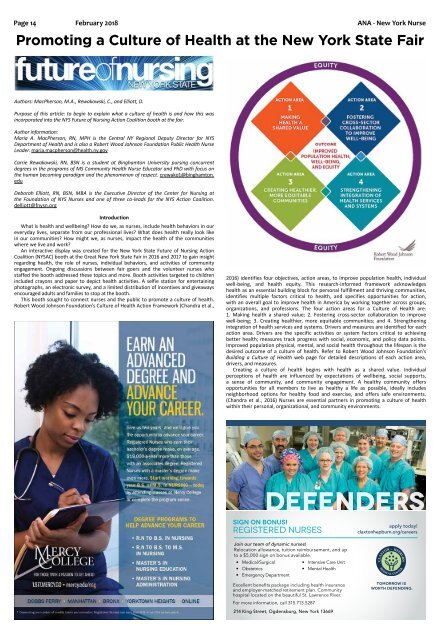ANA - New York Nurse - February 2018
You also want an ePaper? Increase the reach of your titles
YUMPU automatically turns print PDFs into web optimized ePapers that Google loves.
Page 14 <strong>February</strong> <strong>2018</strong> <strong>ANA</strong> - <strong>New</strong> <strong>York</strong> <strong>Nurse</strong><br />
Promoting a Culture of Health at the <strong>New</strong> <strong>York</strong> State Fair<br />
Authors: MacPherson, M.A., Rewakowski, C., and Elliott, D.<br />
Purpose of this article: to begin to explain what a culture of health is and how this was<br />
incorporated into the NYS Future of Nursing Action Coalition booth at the fair.<br />
Author information:<br />
Maria A. MacPherson, RN, MPH is the Central NY Regional Deputy Director for NYS<br />
Department of Health and is also a Robert Wood Johnson Foundation Public Health <strong>Nurse</strong><br />
Leader. maria.macpherson@health.ny.gov<br />
Carrie Rewakowski, RN, BSN is a student at Binghamton University pursing concurrent<br />
degrees in the programs of MS Community Health <strong>Nurse</strong> Educator and PhD with focus on<br />
the human becoming paradigm and the phenomenon of respect. crewako1@binghamton.<br />
edu<br />
Deborah Elliott, RN, BSN, MBA is the Executive Director of the Center for Nursing at<br />
the Foundation of NYS <strong>Nurse</strong>s and one of three co-leads for the NYS Action Coalition.<br />
delliott@fnysn.org<br />
Introduction<br />
What is health and wellbeing? How do we, as nurses, include health behaviors in our<br />
everyday lives, separate from our professional lives? What does health really look like<br />
in our communities? How might we, as nurses, impact the health of the communities<br />
where we live and work?<br />
An interactive display was created for the <strong>New</strong> <strong>York</strong> State Future of Nursing Action<br />
Coalition (NYSAC) booth at the Great <strong>New</strong> <strong>York</strong> State Fair in 2016 and 2017 to gain insight<br />
regarding health, the role of nurses, individual behaviors, and activities of community<br />
engagement. Ongoing discussions between fair goers and the volunteer nurses who<br />
staffed the booth addressed these topics and more. Booth activities targeted to children<br />
included crayons and paper to depict health activities. A selfie station for entertaining<br />
photographs, an electronic survey, and a limited distribution of incentives and giveaways<br />
encouraged adults and families to stop at the booth.<br />
This booth sought to connect nurses and the public to promote a culture of health.<br />
Robert Wood Johnson Foundation’s Culture of Health Action Framework (Chandra et al.,<br />
2016) identifies four objectives, action areas, to improve population health, individual<br />
well-being, and health equity. This research-informed framework acknowledges<br />
health as an essential building block for personal fulfillment and thriving communities,<br />
identifies multiple factors critical to health, and specifies opportunities for action,<br />
with an overall goal to improve health in America by working together across groups,<br />
organizations, and professions. The four action areas for a Culture of Health are:<br />
1. Making health a shared value; 2. Fostering cross-sector collaboration to improve<br />
well-being; 3. Creating healthier, more equitable communities; and 4. Strengthening<br />
integration of health services and systems. Drivers and measures are identified for each<br />
action area. Drivers are the specific activities or system factors critical to achieving<br />
better health; measures track progress with social, economic, and policy data points.<br />
Improved population physical, mental, and social health throughout the lifespan is the<br />
desired outcome of a culture of health. Refer to Robert Wood Johnson Foundation’s<br />
Building a Culture of Health web page for detailed descriptions of each action area,<br />
drivers, and measures.<br />
Creating a culture of health begins with health as a shared value. Individual<br />
perceptions of health are influenced by expectations of wellbeing, social supports,<br />
a sense of community, and community engagement. A healthy community offers<br />
opportunities for all members to live as healthy a life as possible, ideally includes<br />
neighborhood options for healthy food and exercise, and offers safe environments.<br />
(Chandra et al., 2016) <strong>Nurse</strong>s are essential partners in promoting a culture of health<br />
within their personal, organizational, and community environments.

















